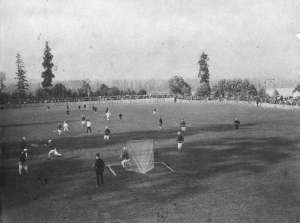
BROCKTON POINT GROUNDS
The Brockton Point Grounds, located on the peninsula of the same name in Stanley Park, are Vancouver’s oldest athletic grounds still in use (by cricket and rugby teams). Its heyday as a lacrosse field was from 1890 until 1905 – although the two seasons it was used by the professionals were in 1918 during the Mainland Lacrosse Association season and then one game in 1922.
The location was originally cleared for a sawmill in 1865 but when the mill was instead built over in Gastown, the site then became one of Vancouver’s earliest sporting grounds. There seems to be some uncertainty pinning down exactly when it was first used for sporting events – although it hosted its first lacrosse match no later than September 1890.
The isolated location and distance from downtown Vancouver made it somewhat unpopular as a venue. It also proved to be unavailable when professional baseball came to town, as the Brockton Point Athletic Association had a strict stipulation that the playing fields were for amateur use only. Once Recreation Park was built downtown in 1905 to solve this issue regarding professionals, the Vancouver Lacrosse Club soon followed baseball across Coal Harbour to the vastly improved, new stadium in April 1906 after disagreements over gate receipts.
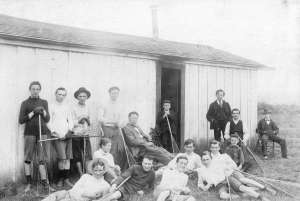
In 1918, Con Jones signed a three-year, $700 per year lease for use of the Brockton Point grounds. By this point, the Parks Commission was controlling Brockton Point so its use by professionals for the Mainland Lacrosse Association season did not face the same opposition which earlier teams had dealt with. After one season however, and with Con Jones now out of the professional game after a dispute over the Minto Cup, lacrosse returned to Athletic Park.
The last recorded lacrosse games from those early days played at Brockton Point are believed to be amateur, holiday exhibition games which occurred in 1929. An exception to this was an exhibition field lacrosse match organised and played in 1986 between the North Shore Indians and a British Columbia Selects team in celebration of the one-hundredth anniversary of both the founding of the city of Vancouver and the first lacrosse game in the province.
The crowd capacity for lacrosse games at Brockton Point is unknown, although the grandstand could hold around 5,000 spectators.
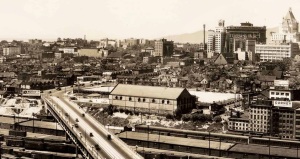
First surveyed and assigned for athletics and sporting pastimes in the 1880s, the Cambie Street grounds were not that well-maintained and deemed unsatisfactory for sporting events well before the time professional lacrosse reached its glory years.
The grounds took up the entire city block bounded by Cambie, Dunsmuir, Beatty and Georgia Streets and was obtained through the persistent efforts of Lauchlan Hamilton, the Canadian Pacific Railway land commissioner and Vancouver’s first surveyor, and MP Arthur Wellington Ross.
In its early years, it could be leased from the Canadian Pacific Railroad for $5 per annum and cows and goats were kept on the grounds as a means to trim the grass. The grounds played host to Vancouver’s first sports event, a rugby game in 1887. Actual lacrosse games at the senior level were only played on the Cambie grounds in 1891, with three matches recorded as being played there.
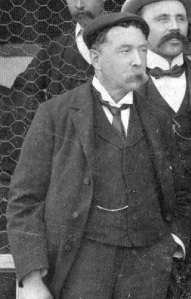
Alfred ‘Al’ Larwill had a shack on the grounds and lived there as a sort of unofficial caretaker from the time after the great fire of 1886 until 1902 when he was ordered to move so the site could be renovated. Larwill passed away on April 2, 1911. The Cambie Street grounds saw more use as a practice field – and its real legacy for the game of lacrosse is that many a young Vancouver lacrosse player honed and perfected his skills under the watchful eye of Larwill. Outstanding lacrosse players such as George Matheson and his brothers Waldo and Earl learnt their trade there while growing up as youngsters.
The Cambie Street grounds were renamed Larwill Park in 1943 in memory of the old caretaker, who has since become a now-forgotten yet important historical personage from the very early days of athletics and sports in Vancouver.
Sadly, the name did not remain in use for long. During the Second World War, the grounds were re-developed and Larwill Park became a bus depot for long-distance buses in 1946. The Greyhound Bus Lines depot remained there until 1993 when it was demolished sometime afterwards. Currently the block is occupied by a parking lot and the downtown farmers market.
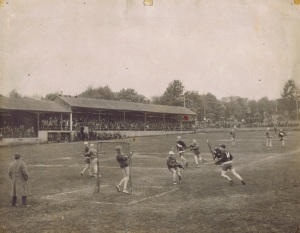
QUEENS PARK
Unlike the Vancouver lacrosse teams which moved around from location to location depending on grounds availability over the years, the New Westminster Salmonbellies were firmly ensconced at Queens Park for their home playing field starting from 1890 onwards. Prior to the construction of Queens Park, Townsend’s Field nearby was used during the first season for New Westminster.
The lacrosse field used by the Salmonbellies was located where the modern baseball diamond is located today. The field was notorious for its noticeable uphill slope which the home team manipulated to their advantage.
A few games at Queens Park, such as when the Montréal Amateur Athletic Association and Montréal Nationals traveled to the Coast in their challenges against New Westminster for the Minto Cup, reached the 16,000 range – but between 10,000 and 12,000 spectators was considered large and 8,000 a fair-sized crowd.
Along with Recreation Park, Queens Park was probably the most photographed of all the lacrosse grounds in British Columbia – with the bulk of the images originating during the 1908 to 1911 period.

Costing somewhere between $25,000 and $30,000 to build, Recreation Park opened in May 1905 as Vancouver’s first downtown stadium structure. It was home to the Vancouver Lacrosse Club as well as Vancouver’s professional baseball team in the Northwest Baseball League.
Located on the block bordered by what is now Homer, Smythe, Mainland, and Nelson Streets, the site was leased from the Canadian Pacific Railroad out of part of their railway reserve lands. At the time, Nelson Street did not go through – and the stretch between Homer and Mainland was part of the grounds.
The location was chosen as Vancouver was in dire need of a downtown sports facility for the growing city. The previously used Brockton Point grounds were deemed inaccessible for larger crowds as well as restricted to use for amateur sporting events.
However, downtown Vancouver was changing quickly. When built in 1905, much of the downtown core had still been lightly developed with large tracts still remaining. But in the boom years which preceded and followed its opening in the first decade of the Twentieth Century, Vancouver’s population quadrupled. The Canadian Pacific Railroad had begun to look at using or selling off the land as early as 1909, just four years after the park had opened its doors to the public.
The 1911 season when Vancouver Lacrosse Club won the Minto Cup saw some of the largest crowds ever at Recreation Park, with a record-breaker in the 10,000 to 11,000 range early in the season on June 3. On Dominion Day, the stadium saw 12,045 in attendance – reported as one of the largest crowds ever to witness a lacrosse game in British Columbia.
The massive crowds would continue into the autumn when Vancouver and New Westminster needed a playoff series as both teams finished splitting the schedule with 5 wins apiece. The 14,009 paid attendance, possibly as many as 15,000, who filled Recreation Park on September 16, 1911 was probably the largest recorded attendance to witness a lacrosse game played in Vancouver until the birth of the Vancouver Ravens of the National Lacrosse League in 2002.
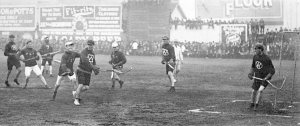
When Toronto Tecumsehs travelled west to challenge Vancouver for the Minto Cup in October 1911, standing room only crowds once again filled Recreation Park to capacity – and beyond – with many spectators watching precariously from neighbouring roof tops, window sills, fences, billboard signs, and even clambering up telephone poles for a view of the action. Oddly enough, the reported attendances for these matches were surprisingly low considering that photographic images from the series imply a completely different picture.
Recreation Park was closed after the 1912 season as Vancouver’s sports teams, forewarned and not surprised by the impending closure, simultaneously made their own arrangements to move elsewhere for their 1913 seasons. The grandstand was disassembled and moved to the new Athletic Park located on the south side of False Creek as the baseball team relocated its operations there. Meanwhile, Con Jones moved his Vancouver Lacrosse Club to the Hastings Park grounds near where he would eventually build a stadium that would bear his name.
Ironically, once the site had been leveled to the ground and all trace of the stadium removed, the vacant lot then sat unused as a blight on the downtown core, an eyesore on the landscape until 1937 when a Safeway storage facility was built on the site. All or parts of the block then later became a parking lot and storage facilities (unknown if the same storage building constructed in 1937) before redevelopment into high-rise condominiums around 2005.
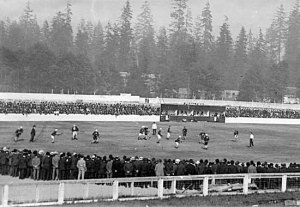
HASTINGS ATHLETIC PARK (1913-1915?)
CON JONES PARK (1921-1971)
With the closure of Recreation Park, the Vancouver Lacrosse Club moved across the city to the wooded wilderness of Hastings Athletic Park for the 1913 season.
Pin-pointing the exact location of the playing grounds can be somewhat confusing as sources and maps sometimes present conflicting and incorrect information. Some sources – such as the atlas Vancouver: A Visual History have the ca.1913 grounds incorrectly located on the site of modern Callister Park where Con Jones’s stadium was located from 1921 until it was demolished in 1971 – while other sources have it correctly located across Renfrew Street in the modern Pacific National Exhibition grounds with the playing field located in the middle of where the Exhibition Park racetrack is currently located.
This confusion is further exacerbated as the newspapers of the day sometimes referred to Hastings grounds as “Con Jones Park” or “Jones Park” starting around 1914 or 1915, well before his stadium was built in 1920-21 – which sometimes gives the impression that there was a stadium structure already on site earlier than 1920.
In September 1920, Con Jones acquired a two-block lot (bounded by Renfrew, Oxford, Sunrise, and Cambridge Streets) across from the PNE Grounds. By May 1921, Jones’s lacrosse teams were making use of the brand-new Con Jones Park and its new wooden stadium. The years when Jones wasn’t involved in the professional game, the Vancouver Terminals were compelled to use Athletic Park. When Jones passed away in 1929, payments on its mortgage ceased and title of the property reverted back to original owner, John Callister – whose heirs later donated it to the City of Vancouver in the 1940s. The old stadium, which had become a shrine for local amateur soccer teams, was demolished in 1971, erasing the last legacy of Con Jones from Vancouver’s sporting map.
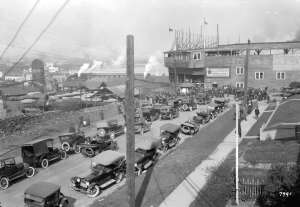
ATHLETIC PARK (1913-1951)
Athletic Park was located on the south shore of False Creek in Vancouver, on the north-east corner of Hemlock Street and West Fifth Avenue overlooking Granville Island. The second grandstand stadium built in Vancouver, it was home to the city’s baseball and lacrosse teams.
The stadium was built and owned by the Canadian Pacific Railway and managed by local baseball legend Bob Brown until 1944, when it was then sold to Emil Sick and his Capilano Breweries, who renamed it Capilano Stadium.
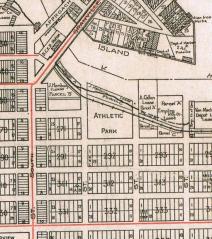
The stadium suffered its second fire the following year and City Hall began to covet the site for construction of a new Granville Street Bridge and its required on-ramps along Hemlock Street as well as extending West Fourth Avenue. After further repairs and renovations to the rickety structure, the stadium was finally acquired by the City and demolished in 1951 – to be replaced by Nat Bailey Stadium at Queen Elizabeth Park.
The stadium was home for the Vancouver Athletic Club and Vancouver Terminals lacrosse teams – although it was generally used more by the various senior amateur teams and leagues than by the professionals, who usually opted for Con Jones Park when it was made available to them for their home grounds in Vancouver. As a general rule of thumb, Athletic Park was used as the home grounds whenever Con Jones was not involved in bankrolling the team in question.
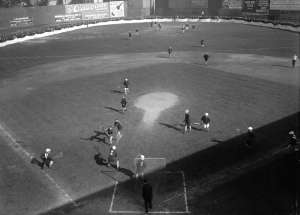
June 4, 1921 featured a unique occurrence when there were two professional lacrosse matches played in the City of Vancouver on the same day, at the same time, when Athletic Park hosted New Westminster in that day’s British Columbia Lacrosse Association game while Con Jones Park across town hosted the visiting Victoria Capitals of the rival Pacific Coast Lacrosse Association.
The modern day site is now dissected and overrun by bridge overpasses, roads, condominiums, concrete, and commercial buildings – with no hint of evidence remaining whatsoever that at one time there was once a 6,000 seat stadium in existence there.
BEACON HILL PARK / CALEDONIAN GROUNDS / ROYAL ATHLETIC PARK / OAK BAY GROUNDS / THE STADIUM
There were five playing grounds used by lacrosse teams in Victoria during the field lacrosse era – with three of them used by the professionals, albeit for just four games.
Beacon Hill Park hosted the first organised lacrosse match played in British Columbia, in 1886, and was used by Victoria senior teams until around 1891.
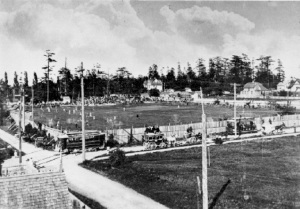
The Caledonian Grounds, which dated from 1887, replaced Beacon Hill Park as the home field for the Victoria Lacrosse Club during the 1891 season, with the first recorded senior game played there on August 15 of that year. Located in the James Bay neighbourhood of Victoria, the park was bounded by Government, Niagara, St. Andrews and Simcoe Streets and owned by the St. Andrews and Caledonian Society.
It is unknown what year the Caledonian Grounds ceased to be used for sporting events and redeveloped into residential housing – although it has been described as one of the last city blocks in the neighbourhood to see redevelopment.
Royal Athletic Park, located on the block bounded by Caledonia, Vancouver, Pembroke, and Cook Streets, was constructed in 1908 as a much needed replacement for the Caledonian Grounds and the Oak Bay Grounds. It underwent renovations after a fire in 1967 and the grounds are still in use for field lacrosse and other amateur sports to this very day.
Of the four professional lacrosse games played in Victoria, one was played at Royal Athletic Park and one at the Oak Bay Grounds. Both of these matches were New Westminster-Vancouver BCLA league games that took place in Victoria during the 1913 season.
The Oak Bay Grounds – now known as Windsor Park – hold the distinction for providing the first Victoria-based team to challenge and compete for the Mann Cup, in 1913. Oak Bay lost their first game 13-0 and then defaulted their second game to Vancouver Athletic Club.
The two other professional matches played in Victoria however actually involved a Victoria team. Both of these took place in June 1921 when Vancouver promoter Con Jones created the Victoria Capitals, a team made up of local lads and Eastern imports, for his upstart Pacific Coast Lacrosse Association as competition for his Vancouver Lacrosse Club.
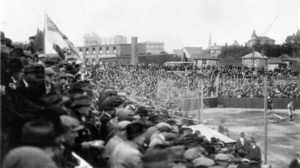
In May of 1920, a new stadium was constructed on a vacant lot behind the Empress Hotel on Douglas Street where the Crystal Garden is now located.
Referred in the local press as just ‘The Stadium’, it was used mostly by local professional and amateur baseball teams – but it was also briefly the home field for the Victoria Capitals lacrosse team in 1921. The Stadium hosted two home games for Victoria before the league folded after five games and three weeks of play.
Its capacity was reported to be 7,000 and the Victoria Daily Colonist spoke very highly of the venue during its construction – giving it high hopes for the future.
As it turned out, the Stadium’s sporting existence was very brief – no more than four years – as it was demolished at some point before the Crystal Garden was built and opened on the site in June 1925.
(PHOTO SOURCES: CVA Sp P90; CVA Sp P2; Leonard Frank collection 1939; CLHOF X994.10; CVA PAN P87; CVA 371-596; CVA 371-576; CVA 99-870; CVA 99-1020; BC Archives BCA G-02816)